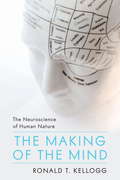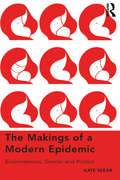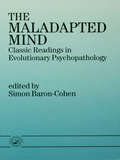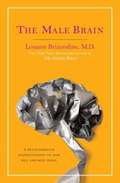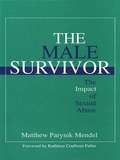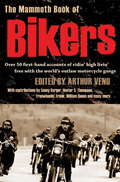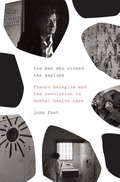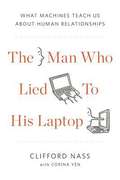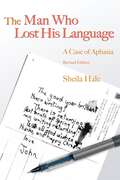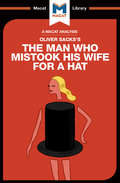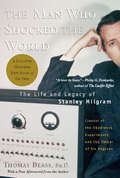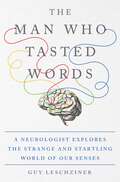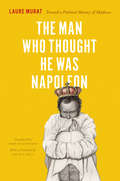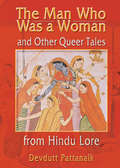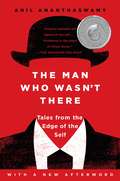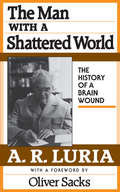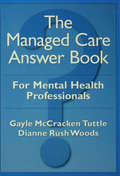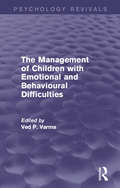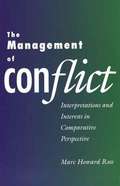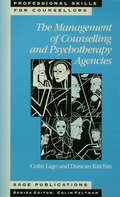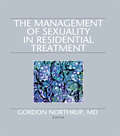- Table View
- List View
The Making of the Mind
by Ronald T. KelloggUsing the findings of recent neuroscience, a psychologist reveals what sets humans apart from all other species, offering a fascinating exploration of our marvelous and sometimes frightening cognitive abilities and potentials. According to human genome research, there is a remarkable degree of overlap in the DNA of humans and chimpanzees. So what accounts for the rapid development of human culture throughout history and the extraordinary creative and destructive aspects of human behavior that make us so different from our primate cousins? Kellogg explores in detail five distinctive parts of human cognition. These are the executive functions of working memory; a social intelligence with "mind-reading" abilities; a capacity for symbolic thought and language; an inner voice that interprets conscious experiences by making causal inferences; and a means for mental time travel to past events and imagined futures. He argues that it is the interaction of these five components that results in our uniquely human mind. This is especially true for three quintessentially human endeavors-morality, spirituality, and literacy, which can be understood only in light of the whole ensemble's interactive effects. Kellogg recaps the story of the human mind and speculates on its future. How might the Internet, 24/7 television, and smart phones affect the way the mind functions?
The Makings of a Modern Epidemic: Endometriosis, Gender and Politics
by Kate SeearSince its ’discovery’ some 150 years ago, thinking about endometriosis has changed. With current estimates identifying it as more common than breast and ovarian cancer, this chronic, incurable gynaecological condition has emerged as a ’modern epidemic’, distinctive in being perhaps the only global epidemic peculiar to women. This timely book addresses the scholarly neglect of endometriosis by the social sciences, offering a critical assessment of one of the world’s most common - and burdensome - health problems for women. Drawing on a range of theoretical perspectives, including science and technology studies, feminist theory and queer theory, The Makings of a Modern Epidemic explores the symbolic, discursive and material dimensions of the condition. It demonstrates how shifts in thinking about gender, the body, race, modernity and philosophies of health have shaped the epidemic, and produces a compelling account of endometriosis as a highly politicised and grossly neglected disease. Drawing upon rich empirical data, including in-depth interviews with women who have endometriosis and medical and self-help literature, this ground-breaking volume will appeal to scholars and students across the social sciences with interests in gender studies, science and technology studies and the sociology and anthropology of medicine, health and the body.
The Maladapted Mind: Classic Readings in Evolutionary Psychopathology
by Simon Baron-CohenNewly available in paperback, this is the first book to bring together classic and contemporary readings illustrating the new subdiscipline, evolutionary psychopathology. Each chapter demonstrates how evolutionary arguments are being brought to bear on the study of a different psychiatric condition or pathalogical behaviour. The Maladapted Mind is aimed primarily at primarily at advanced students and researchers in the fields of psychiatry, abnormal psychology, biological anthropology, evolutionary biology and cognitive science.
The Male Brain: A Breakthrough Understanding of How Men and Boys Think
by Louann BrizendineFrom the author of the groundbreaking New York Times bestseller The Female Brain, here is the eagerly awaited follow-up book that demystifies the puzzling male brain. Dr. Louann Brizendine, the founder of the first clinic in the country to study gender differences in brain, behavior, and hormones, turns her attention to the male brain, showing how, through every phase of life, the "male reality" is fundamentally different from the female one. Exploring the latest breakthroughs in male psychology and neurology with her trademark accessibility and candor, she reveals that the male brain: *is a lean, mean, problem-solving machine. Faced with a personal problem, a man will use his analytical brain structures, not his emotional ones, to find a solution. *thrives under competition, instinctively plays rough and is obsessed with rank and hierarchy. *has an area for sexual pursuit that is 2.5 times larger than the female brain, consuming him with sexual fantasies about female body parts. *experiences such a massive increase in testosterone at puberty that he perceive others' faces to be more aggressive.The Male Brain finally overturns the stereotypes. Impeccably researched and at the cutting edge of scientific knowledge, this is a book that every man, and especially every woman bedeviled by a man, will need to own.Praise for The Female Brain:"Louann Brizendine has done a great favor for every man who wants to understand the puzzling women in his life. A breezy and enlightening guide to women and a must-read for men."--Daniel Goleman, author of Emotional Intelligence From the Hardcover edition.
The Male Survivor: The Impact of Sexual Abuse
by Matthew Parynik MendelThis landmark study examines the largest clinical sample to date of male survivors of sexual abuse in childhood. Using data from his nationwide North American survey, the author reveals that such abuse is extensive, thus dispelling myths regarding the invulnerability of males. Mendel argues that various societal myths have led to a profound under-recognition of male childhood sexual abuse. He proposes that increased attention to, and acknowledgement of, male victimization is needed in order to reduce both the stigma and isolation of male survivors and the incidence of abuse. The author also suggests modifications to conceptual frameworks related to the long-term impact of childhood sexual abuse to apply specifically to male
The Malleability of Intellectual Styles
by Li-Fang ZhangIntellectual styles are individuals' preferred ways of using the cognitive abilities that they possess. The extent to which one can change his or her intellectual style is a question of interest to both researchers and the general public. This book presents the first comprehensive and systematic review of existing research on the malleability of intellectual styles. By critically analyzing research findings derived from both cross-sectional and longitudinal investigations performed over the past seven decades, Li-fang Zhang demonstrates that intellectual styles can be modified through both socialization and purposeful training. Professor Zhang elucidates the heuristic value of these findings for the development of adaptive intellectual styles in both academic and nonacademic settings. She proposes further avenues of research that might advance scholarly understanding of the nature and the potential for modifying intellectual styles.
The Mammoth Book of Bikers: Over 40 first-hand accounts of riding high, living free, with the world's outlaw motorcycle gangs (Mammoth Books #464)
by Arthur VenoThe definitive collection of first-hand accounts of the world's outlaw motorcycle gangs, with contributions by Sonny Barger, Hunter S. Thompson, Ed Winterhalder, William Queen and many moreOutlaw bikers consider themselves 'the last free people in society', unconstrained by the regulations that hem in ordinary citizens. And they guard their privacy jealously. Drawing on seventeen years of studying and participating in biker culture, the author has compiled this one-of-a-kind collection of original biker writing.Here are insider accounts of landmark incidents in biker folklore, including reprints of classic writing from biker-originated magazines, handouts, websites and books. Gangs featured include the Bandidos, the Hells Angels, Henchmen MC, the Outlaws, the Mongols, the Annihilators, the Diablos, the Gypsy Jokers, the Rebels, the Straight Satans and the Vagos. And with contributors such as Freewheelin' Frank (one-time secretary of the Hells Angels), Edward Winterhalder (among the most powerful members of the Bandidos) and Sonny Barger (founder of the Hells Angels). Also included are those rare accounts by outsiders who have succeeded in 'looking in' on the gangs: Hunter S. Thompson's Hells Angels: A Strange and Terrible Modern Saga; writing by William Queen, the undercover agent who infiltrated America's violent outlaw motorcycle gang the Mongols; and Daniel R. Wolf's account of riding with the Rebels.
The Man Who Closed the Asylums: Franco Basaglia and the Revolution in Mental Health Care
by John FootWhen the wind of the 1960s blew through the world of psychiatry In 1961, when Franco Basaglia arrived outside the grim walls of the Gorizia asylum, on the Italian border with Yugoslavia, it was a place of horror, a Bedlam for the mentally sick and excluded, redolent of Basaglia's own wartime experience inside a fascist gaol. Patients were frequently restrained for long periods, and therapy was largely a matter of electric and insulin shocks. The corridors stank, and for many of the interned the doors were locked for life. This was a concentration camp, not a hospital.Basaglia, the new Director, was expected to practise all the skills of oppression in which he had been schooled, but he would have none of this. The place had to be closed down by opening it up from the inside, bringing freedom and democracy to the patients, the nurses and the psychiatrists working in that "total institution."Inspired by the writings of authors such as Primo Levi, R.D. Laing, Erving Goffman, Michel Foucault and Frantz Fanon, and the practices of experimental therapeutic communities in the UK, Basaglia's seminal work as a psychiatrist and campaigner in Gorizia, Parma and Trieste fed into and substantially contributed to the national and international movement of 1968. In 1978 a law was passed (the "Basaglia law") which sanctioned the closure of the entire Italian asylum system.The first comprehensive study of this revolutionary approach to mental health care, The Man Who Closed the Asylums is a gripping account of one of the most influential movements in twentieth-century psychiatry, which helped to transform the way we see mental illness. Basaglia's work saved countless people from a miserable existence, and his legacy persists, as an object lesson in the struggle against the brutality and ignorance that the establishment peddles to the public as common sense.From the Hardcover edition.
The Man Who Lied to His Laptop: What We Can Learn About Ourselves from Our Machines
by Nass Clifford Yen CorinaLying to a laptop so we don't hurt its feelings; yelling at a GPS in frustration; feeling flattered by random praise from a computer-people act strangely around artificial intelligence. Stranger still that how we act around computers is so similar to how we act towards other people, and that we can learn a lot about human interaction from how we respond to computers. Pioneering researcher Clifford Nass has done numerous experiments centered around human/computer interaction that not only expose the similarities between how we act towards technology and how we act toward people, but illuminate the surprising nature of person-to-person interactions. Nass has been able to show that, from flattery to empathy to loyalty, many aspects of human behavior and emotion are identical whether we're dealing with computers or people. Based on his findings, Nass has developed rules for successful relationships in any area of life. For instance: Don't smile to soften criticism-match your delivery to your content for best results Crack jokes-innocent humor makes people happier with their work without harming their efficiency (and the joke doesn't even have to be funny!) Empathize-acting happy around a sad person (or vice versa) makes that person perform demonstrably worse at task The way we treat computers has deep ramifications for everything from praise and criticism to credibility to team-building. Nass is pushing into the next frontier of behavioral science.
The Man Who Lost his Language: A Case of Aphasia Revised Edition
by Sheila HaleThe Man who Lost His Language is a unique exploration of aphasia - losing the ability to use or comprehend words - as well as of the resilience of love. When Sir John Hale suffered a stroke that left him unable to walk, write or speak, his wife, Shelia, followed every available medical trail seeking knowledge of his condition and how he might be restored to health. This revised edition of a classic book includes an additional chapter detailing the latest developments in science and medicine since the first edition was published. This personal account of one couple's experience will be of interest to all those who want to know more about aphasia and related conditions.
The Man Who Mapped Consciousness: The Life and Legacy of Dr. David R. Hawkins, The Authorized Biography
by Susan HawkinsA biography of the late spiritual pioneer Dr. David R. Hawkins, or "Doc" as he was known to many of his devotees."This is more than a biography; it&’s a heartfelt journey, an invitation to experience his life and witness the extraordinary legacy he left behind."Dr. David R. Hawkins, a man whose existence was a symphony of curiosity, discovery, and transformation, a man, who not only was a brilliant thinker, but a man of deep compassion and love, dedicated to the upliftment of all of humanity.From his discoveries as a science-based psychiatrist to the confirmed reality of his own unique spiritual experiences, David R. Hawkins has gifted us with a treasure trove of insights into the human psyche and consciousness itself, that are as mind-blowing as they are soul-nourishing. He handed us a road map to Truth with his visionary Map of Consciousness®, an extremely useful guide in gaining profound insights into the nature or our existence and purpose on earth.In this book, you will come face to face with the revelations that turned his world upside down and elevated the consciousness of anyone fortunate enough to encounter his work.Let&’s begin this journey of Dr. David R. Hawkins, an extraordinary yet ordinary life whose imprint on the world stands for Truth as the highest endeavor, embraces compassion for all sentient beings, and in complete surrender and devotion to God as the Ultimate Reality.
The Man Who Mistook His Wife For a Hat
by Alexander O' Connor Dario KrpanIn The Man Who Mistook His Wife for a Hat, neurologist Oliver Sacks looked at the cutting-edge work taking place in his field, and decided that much of it was not fit for purpose. Sacks found it hard to understand why most doctors adopted a mechanical and impersonal approach to their patients, and opened his mind to new ways to treat people with neurological disorders. He explored the question of deciding what such new ways might be by deploying his formidable creative thinking skills. Sacks felt the issues at the heart of patient care needed redefining, because the way they were being dealt with hurt not only patients, but practitioners too. They limited a physician’s capacity to understand and then treat a patient’s condition. To highlight the issue, Sacks wrote the stories of 24 patients and their neurological clinical conditions. In the process, he rebelled against traditional methodology by focusing on his patients’ subjective experiences. Sacks did not only write about his patients in original ways – he attempt to come up with creative ways of treating them as well. At root, his method was to try to help each person individually, with the core aim of finding meaning and a sense of identity despite, or even thanks to, the patients’ condition. Sacks thus redefined the issue of neurological work in a new way, and his ideas were so influential that they heralded the arrival of a broader movement – narrative medicine – that placed stronger emphasis on listening to and incorporating patients’ experiences and insights into their care.
The Man Who Shocked The World: The Life and Legacy of Stanley Milgram
by Thomas BlassCreator of the famous Obedience Experiments and originator of the ?six degrees of separationOCO theory, Stanley Milgram transformed our understanding of human nature and continues to be one of the most important figures in psychology and beyond. In this sparkling biography, Thomas Blass captures the colorful personality and pioneering work of a visionary scientist who revealed the hidden workings of our social world. In this new paperback edition, he includes an afterword connecting MilgramOCOs theories to torture, war crimes, and Abu Ghraib. "
The Man Who Tasted Words: A Neurologist Explores the Strange and Startling World of Our Senses
by Dr. Guy LeschzinerIn The Man Who Tasted Words, Guy Leschziner leads readers through the senses and how, through them, our brain understands or misunderstands the world around us.Vision, hearing, taste, smell, and touch are what we rely on to perceive the reality of our world. Our senses are the conduits that bring us the scent of a freshly brewed cup of coffee or the notes of a favorite song suddenly playing on the radio. But are they really that reliable? The Man Who Tasted Words shows that what we perceive to be absolute truths of the world around us is actually a complex internal reconstruction by our minds and nervous systems. The translation into experiences with conscious meaning—the pattern of light and dark on the retina that is transformed into the face of a loved one, for instance—is a process that is invisible, undetected by ourselves and, in most cases, completely out of our control.In The Man Who Tasted Words, neurologist Guy Leschziner explores how our nervous systems define our worlds and how we can, in fact, be victims of falsehoods perpetrated by our own brains. In his moving and lyrical chronicles of lives turned upside down by a disruption in one or more of their five senses, he introduces readers to extraordinary individuals, like one man who actually “tasted” words, and shows us how sensory disruptions like that have played havoc, not only with their view of the world, but with their relationships as well. The cases Leschziner shares in The Man Who Tasted Words are extreme, but they are also human, and teach us how our lives and what we perceive as reality are both ultimately defined by the complexities of our nervous systems.
The Man Who Thought He Was Napoleon: Toward a Political History of Madness
by Laure Murat translated by Deke DusinberreThe Man Who Thought He Was Napoleon is built around a bizarre historical event and an off-hand challenge. The event? In December 1840, nearly twenty years after his death, the remains of Napoleon were returned to Paris for burial--and the next day, the director of a Paris hospital for the insane admitted fourteen men who claimed to be Napoleon. The challenge, meanwhile, is the claim by great French psychiatrist Jean-Étienne-Dominique Esquirol (1772-1840) that he could recount the history of France through asylum registries. From those two components, Laure Murat embarks on an exploration of the surprising relationship between history and madness. She uncovers countless stories of patients whose delusions seem to be rooted in the historical or political traumas of their time, like the watchmaker who believed he lived with a new head, his original having been removed at the guillotine. In the troubled wake of the Revolution, meanwhile, French physicians diagnosed a number of mental illnesses tied to current events, from "revolutionary neuroses” and "democratic disease” to the "ambitious monomania” of the Restoration. How, Murat asks, do history and psychiatry, the nation and the individual psyche, interface? A fascinating history of psychiatry--but of a wholly new sort--The Man Who Thought He Was Napoleon offers the first sustained analysis of the intertwined discourses of madness, psychiatry, history, and political theory.
The Man Who Was a Woman and Other Queer Tales from Hindu Lore
by Devdutt PattanaikA god transforms into a nymph and enchants another god.A king becomes pregnant.A prince discovers on his wedding night that he is not a man.Another king has children who call him both father and mother. A hero turns into a eunuch and wears female apparel. A princess has to turn into a man before she can avenge her humiliation. Widows of a king make love to conceive his child. Friends of the same sex end up marrying each other after one of them metamorphoses into a woman. These are some of the tales from Hindu lore that this unique book examines. The Man Who Was a Woman and Other Queer Tales from Hindu Lore is a compilation of traditional Hindu stories with a common thread: sexual transformation and gender metamorphosis. In addition to the thought-provoking stories in The Man Who Was a Woman and Other Queer Tales from Hindu Lore, you'll also find: an examination of the universality of queer narratives with examples from Greek lore and Irish folklore a comparison of the Hindu paradigm to the biblical paradigm a look at how Hindu society and Hindu scripture responds to queer sexuality a discussion of the Hijras, popularly believed to be the “third gender” in India--their probable origin, and how they fit into Hindu societyWith the telling of each of these tales, you will also learn how the author came upon each of them and how they relate to the context of dominant Hindu attitudes toward sex, gender, pleasure, fertility, and celibacy.
The Man Who Wasn't There
by Anil AnanthaswamyIn the tradition of Oliver Sacks, a tour of the latest neuroscience of schizophrenia, autism, Alzheimer's disease, ecstatic epilepsy, Cotard's syndrome, out-of-body experiences, and other disorders--revealing the awesome power of the human sense of self from a master of science journalismAnil Ananthaswamy's extensive in-depth interviews venture into the lives of individuals who offer perspectives that will change how you think about who you are. These individuals all lost some part of what we think of as our self, but they then offer remarkable, sometimes heart-wrenching insights into what remains. One man cut off his own leg. Another became one with the universe.We are learning about the self at a level of detail that Descartes ("I think therefore I am") could never have imagined. Recent research into Alzheimer's illuminates how memory creates your narrative self by using the same part of your brain for your past as for your future. But wait, those afflicted with Cotard's syndrome think they are already dead; in a way, they believe that "I think therefore I am not." Who--or what--can say that? Neuroscience has identified specific regions of the brain that, when they misfire, can cause the self to move back and forth between the body and a doppelgänger, or to leave the body entirely. So where in the brain, or mind, or body, is the self actually located? As Ananthaswamy elegantly reports, neuroscientists themselves now see that the elusive sense of self is both everywhere and nowhere in the human brain.
The Man Who Wasn't There: Investigations into the Strange New Science of the Self
by Anil Ananthaswamy*Nominated for the 2016 PEN/E.O. Wilson Literary Science Writing Award**An NBC News Notable Science Book of 2015**Named one of Publishers Weekly's Best Books of 2015**A Book of the Month for Brain HQ/Posit Science**Selected by Forbes as a Must Read Brain Book of 2015* *On Life Changes Network's list of the Top 10 Books That Could Change Your Life of 2015*In the tradition of Oliver Sacks, a tour of the latest neuroscience of schizophrenia, autism, Alzheimer's disease, ecstatic epilepsy, Cotard's syndrome, out-of-body experiences, and other disorders--revealing the awesome power of the human sense of self from a master of science journalism. Anil Ananthaswamy's extensive in-depth interviews venture into the lives of individuals who offer perspectives that will change how you think about who you are. These individuals all lost some part of what we think of as our self, but they then offer remarkable, sometimes heart-wrenching insights into what remains. One man cut off his own leg. Another became one with the universe. We are learning about the self at a level of detail that Descartes ("I think therefore I am") could never have imagined. Recent research into Alzheimer's illuminates how memory creates your narrative self by using the same part of your brain for your past as for your future. But wait, those afflicted with Cotard's syndrome think they are already dead; in a way, they believe that "I think therefore I am not." Who--or what--can say that? Neuroscience has identified specific regions of the brain that, when they misfire, can cause the self to move back and forth between the body and a doppelgänger, or to leave the body entirely. So where in the brain, or mind, or body, is the self actually located? As Ananthaswamy elegantly reports, neuroscientists themselves now see that the elusive sense of self is both everywhere and nowhere in the human brain.From the Hardcover edition.
The Man Who Wasn't There: Investigations into the Strange New Science of the Self
by Anil Ananthaswamy*Nominated for the 2016 PEN/E.O. Wilson Literary Science Writing Award**An NBC News Notable Science Book of 2015**Named one of Publishers Weekly's Best Books of 2015**A Book of the Month for Brain HQ/Posit Science**Selected by Forbes as a Must Read Brain Book of 2015* *On Life Changes Network's list of the Top 10 Books That Could Change Your Life of 2015*In the tradition of Oliver Sacks, a tour of the latest neuroscience of schizophrenia, autism, Alzheimer's disease, ecstatic epilepsy, Cotard's syndrome, out-of-body experiences, and other disorders--revealing the awesome power of the human sense of self from a master of science journalism. Anil Ananthaswamy's extensive in-depth interviews venture into the lives of individuals who offer perspectives that will change how you think about who you are. These individuals all lost some part of what we think of as our self, but they then offer remarkable, sometimes heart-wrenching insights into what remains. One man cut off his own leg. Another became one with the universe. We are learning about the self at a level of detail that Descartes ("I think therefore I am") could never have imagined. Recent research into Alzheimer's illuminates how memory creates your narrative self by using the same part of your brain for your past as for your future. But wait, those afflicted with Cotard's syndrome think they are already dead; in a way, they believe that "I think therefore I am not." Who--or what--can say that? Neuroscience has identified specific regions of the brain that, when they misfire, can cause the self to move back and forth between the body and a doppelgänger, or to leave the body entirely. So where in the brain, or mind, or body, is the self actually located? As Ananthaswamy elegantly reports, neuroscientists themselves now see that the elusive sense of self is both everywhere and nowhere in the human brain.From the Hardcover edition.
The Man with a Shattered World: The History of a Brain Wound
by A. R. LuriaRussian psychologist A. R. Luria presents a compelling portrait of a man’s heroic struggle to regain his mental faculties. A soldier named Zasetsky, wounded in the head at the battle of Smolensk in 1943, suddenly found himself in a frightening world: he could recall his childhood but not his recent past; half his field of vision had been destroyed; he had great difficulty speaking, reading, and writing. Much of the book consists of excerpts from Zasetsky’s own diaries. Laboriously, he records his memories in order to reestablish his past and to affirm his existence as an intelligent being. Luria’s comments and interpolations provide a valuable distillation of the theory and techniques that guided all of his research. His “digressions” are excellent brief introductions to the topic of brain structure and its relation to higher mental functions.
The Managed Care Answer Book
by Gayle McCracken Tuttle Dianne Rush WoodsFirst published in 1997. Routledge is an imprint of Taylor & Francis, an informa company.
The Management of Children with Emotional and Behavioural Difficulties (Psychology Revivals)
by Ved P. VarmaThe management of children with emotional and behavioural difficulties has always been a source of worry and concern to those who have to deal with them. Many such children are unpredictable, sometimes embarrassing, and can often make us feel helpless. We need to know more about them, and why they think, feel, and behave as they do. Originally published in 1990, the contributors to this volume bring a wide-ranging professional, practical approach to the problem, looking at it from the perspectives of psychiatry, psychology, psychotherapy, education, and social work. They underline the fact that such behaviour cannot be assessed in isolation from the context in which it occurs, and go beyond a mere description of maladjusted children to ask, ‘Maladjusted to what? And under what conditions?’ The social and family context is continually borne in mind. The book will still be of great interest to psychologists, psychiatrists, psychotherapists, teachers and social workers, as well as to students in those disciplines, who will find it an invaluable source to help them in their first encounters with child patients, clients and pupils.
The Management of Conflict: Interpretations and Interests in Comparative Perspective
by Marc Howard RossTopics include: Political anthropology, Conflict management in cross-cultural studies, and Ethnopsychology.
The Management of Counselling and Psychotherapy Agencies (Professional Skills for Counsellors Series)
by Mr Colin Lago Mr Duncan KitchinThe authors of this book provide clear guidelines on the many aspects of knowledge, skill and management expertise increasingly required by all counselling services. Due consideration and detailed advice is given on a broad range of essential issues, from setting up a counselling service to customer relations and quality control. Topics examined include: implications of funding; budgeting; staffing; location and furnishing of premises; daily working routines; how to ensure a competent, professional, safe and ethical working practice; and the sheer complexities of being a manager of therapists.
The Management of Sexuality in Residential Treatment
by Gordon NorthrupHere are practical ideas and help for dealing with problems of sexuality in residential treatment settings. On a day-to-day level, difficulties can arise from the need for child care workers to maintain caring and personal relationships with children in the face of the children’s and their own sexuality. Children themselves also may have difficulties in properly expressing their sexuality. The Management of Sexuality in Residential Treatment examines a broad range of problems that often occur and describes several treatment programs and strategies for coping with incidents of abuse or alleged abuse.Chapters in the book address issues pertinent for professionals working with children in residential treatment. Authors cover topics such as: residents’needs for love versus sexuality the impact of sexually stimulating materials erotic countertransference in a residential treatment center survey of minor sex problems in the milieu and how to respond to them personal relationships between residents and staffThe book also describes two treatment programs for abused or abusing children. The first is an eight week multimodal therapeutic program for adolescent girls who have been sexually abused, the other a course for sexually abusive boys that includes counseling, sex education, and journal writing. The Management of Sexuality in Residential Treatment is a valuable resource for the staff of residential treatment centers, group homes, residential schools, and hospital pediatric units who wish to understand how to deal more effectively with issues of sexuality and the children for whom they care.
